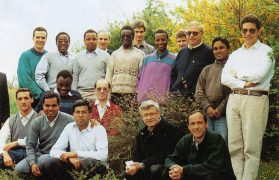I find it useful at times for little mistakes to be made where it is not a question of sin, for when corrected, they help us to know better and to become more imbued with the spirit of our Institute.
Magdalene was born in Verona the 1 of march 1774, a descent of the noble family “Canossa”. She was the third of six children. Yet, as a child, she felt the desire to consecrate herself to God and this desire matured through life experiences (the dead of her father, the second marriage of the mother, an illness, incomprehensions).
As she lived in the climate of tragic events of war and political circumstances of the French Revolution, Magdalene discovered, in deep prayer, the “greatest” love of God, revealed in Christ Crucified.
Look at more: knowing of the plan of God
She sees the face of Jesus in the poor, alienated and suffering people in the suburb of Verona (San Zeno). Since that time she desired to dedicate herself at the service of Christ and His poor.

She decided to leave the palace, but she meet the strong opposition of her family.
The circumstances costrain her to assume the leadership of the family in the palace Canossa. Magdalene coltivated her vocation in the depth of her heart, engaging herself entirely to the everyday duties of the family. In the 1808 she overcame the opposition of her uncle and left the native palace Canossa – renouncing the wealth and the title of marchioness – and together with the first companions founded in Verona, 8 of may 1808 her “Work of Charity”.
See more:catechesis
23 of decembre 1828 obtained the approval from the Apostolic See of the Institute of the Daughters of Charity Servants of the Poor. It was already present in the cities of Venice, Milan, Bergamo and Trent.

As a “Daughter of Charity”, full of an ardour – while the number of the members od the Institute was increasing – on the 23 of May 1831 Magdalene started the male branch: the Institute of the “Sons of Charity”. The male members of this Institute dedicated themselves for the formation of boys and men. (You are invited to visit the page of the Sons of Charity: Canossian Brothers )
The extremely active and fruitful life of Magdalene came to an end on 10 of April 1835. She was 61 years old.
The 8 of December 1941 Pope Pius XII beatificated her in Rome. 47 years later, 2 of October 1988 Pope John Paul II canonized her and thus she was included among the Saints.
“Love is like a flame” – this was her motto. In the course of the years the number of Sisters and Communities increased and became a large Religious Family, dedicated for the spreading of the Kingdom of God and to make Jesus known and loved. Today the Canossian Family include the Sons and Daughters of Charity, the Lay Canossians and the Missionaries of Saint Magdalene.
The spirit and work of charity of Saint Magdalene is now developed in 36 countries of the world.
Magdalena who lived in the time when women couldn’t go to the mission, had a heart throughout missionary. She often explained fervent desire to go even to the conrers of the earth to make Jezus know – as she accented – “Jesus is not loved, because he is not known”.
In 1860 her profound desire became reality. Divine Providence let her sisters reach an Asian continent, because they responded for an invitation from Hong Kong, thanks to the patriach of Venice, Angelo Ramazzotti.
In this way canossian charism from that country spread in the other part of asian countries.



